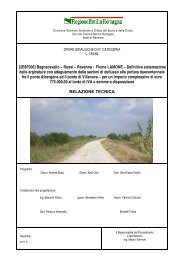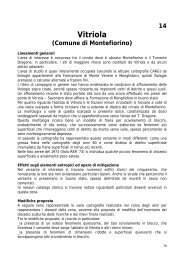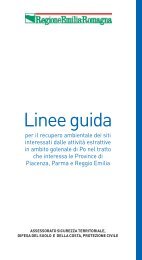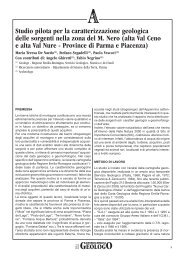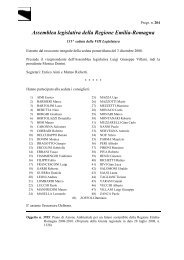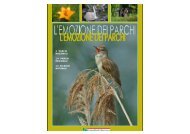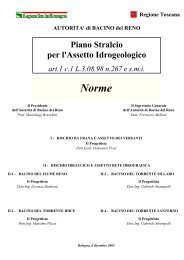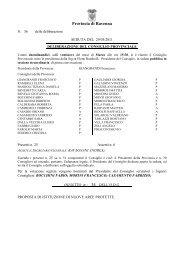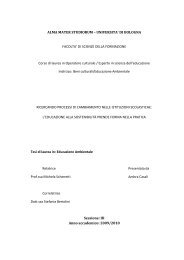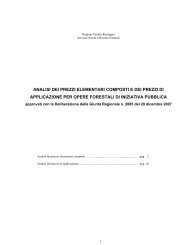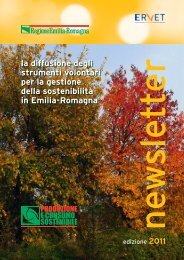air, water and soil quality qualité - ER Ambiente - Regione Emilia ...
air, water and soil quality qualité - ER Ambiente - Regione Emilia ...
air, water and soil quality qualité - ER Ambiente - Regione Emilia ...
You also want an ePaper? Increase the reach of your titles
YUMPU automatically turns print PDFs into web optimized ePapers that Google loves.
disa farm, values are remarkably lower, probably in connection with removals determined<br />
by crops typologies <strong>and</strong> by the homogenization of surface horizons, determined<br />
by periodical tillage activities.<br />
The pinewood <strong>soil</strong>s are usually poorly or weakly calcareous at surface <strong>and</strong> became<br />
moderately or very calcareous in subsurface horizons. Said trend reveals a remarkable<br />
surface decarbonation, favoured by the coarse texture <strong>and</strong> by the consequent<br />
high permeability of these <strong>soil</strong>s. The decarbonation process is also indicated by the<br />
pH trend, which is basically neutral or subacid at surface <strong>and</strong> turns into subalkaline<br />
or moderately alkaline at depth.<br />
The <strong>soil</strong>s of both the public park <strong>and</strong> the farm appear very calcareous from the<br />
surface <strong>and</strong> become strongly calcareous at depth. Therefore in these <strong>soil</strong>s the decarbonation<br />
process seems to be not so evident as against surface horizons, both<br />
due to the reduced permeability (finer textures) <strong>and</strong> to the rearrangement operated<br />
by man. Moreover the values of CaCO3 show a discontinuous trend in relation to<br />
depth, which is suggestive of subsequent sediments contributions, unlike what observed<br />
in almost all the pinewood <strong>soil</strong>s. As a direct consequence of the elevated<br />
rates in CaCO3, the pH value of public park or farm <strong>soil</strong>s prove to be weakly to<br />
strongly alkaline, with trends generally decreasing with depth, except for profile<br />
P<strong>ER</strong>2 that shows non-linear trends.<br />
As to <strong>soil</strong>s electrical conductivity (EC), table 2 shows that no salinization problems<br />
arise either in the public park <strong>soil</strong>s or in the farm ones. However things are different<br />
inside the pinewood where a more articulated situation can be observed.<br />
Some <strong>soil</strong>s have a widespread salinity all along the profile (PW3, PW5, PW7 <strong>and</strong><br />
PW9); others only at surface (PW1), <strong>and</strong> some others absence of salinity (PW2,<br />
PW4, PW6 <strong>and</strong> PWN8).<br />
The electrical conductivity recorded in <strong>soil</strong>s results to be, in said litoraneous environments,<br />
strongly related with the one of ground<strong>water</strong>. Studies recently carried<br />
out in the same area (Zannoni, 2008; Buscaroli <strong>and</strong> Zannoni, 2009) clearly indicate<br />
how, in <strong>soil</strong>s belonging to more elevated areas from a topographical point of view<br />
(PW2, PW4, PW6 <strong>and</strong> PW8), the stratum is located at such a depth as to determine<br />
any possible consequence on deep horizons only (beyond 1 m of depth) while not<br />
affecting the surface.<br />
In inter-dune depressions, where the <strong>water</strong> table is at lower depths, it can significantly<br />
affect the <strong>soil</strong>s characteristics. In particular, when the <strong>water</strong> table is strongly<br />
characterized by salinity as in the case of profiles PW2, PW4, PW6 <strong>and</strong> PW8, the<br />
EC of the whole profiles turns out to be elevated. Moreover, during the summer<br />
period, to coincide with strong surface evapotranspiration phenomena, a large increase<br />
in surface horizons EC has been observed, mainly due to saline accumulations,<br />
which can be observed also in investigated profiles.<br />
Soils classification. Data gathered have made it possible to locate <strong>soil</strong>s from a<br />
taxonomical point of view, according to what provided for in the Keys to <strong>soil</strong> taxonomy,<br />
10 th edition (SSS, 2006), up to the family hierarchical level (table 3).<br />
124



